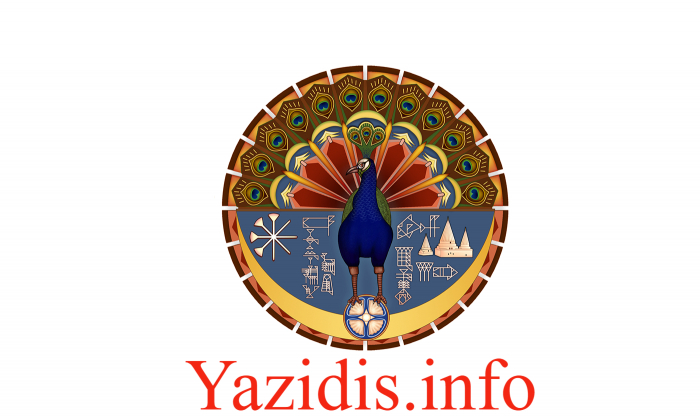Peacock symbol is very significant in many cultures

The peacock symbol is significant in many cultures, it is often associated with beauty, immortality and divinity.
Peacock is one of the oldest symbols in the world, it can be found on the walls of ancient temples and palaces of India, Mesopotamia, Iran, Byzantium, etc. Peacocks are often found on the walls of Christian churches and religious attributes in Georgia, Armenia, Russia and many European cities, and the peacock symbol can also sometimes be found in mosques and synagogues.
For Yazidis, the personification of the peacock (Tause Malak in Yazidi.) is the most important symbol. If Christians have a dove as a symbol and manifestation of the Holy Spirit, then Yazidis have a peacock as a symbol of the main angel, who is also one of the hypostases of the Creator.
Two peacocks are carved above the entrance to the Lalish temple (Iraq), and also decorate the entrance and wall of the Yazidi temple in Tbilisi. Two peacocks opposing each other, and between them the symbol of the world tree, which in Yazidi symbolism means the diversity and colorfulness of the world. This symbol is also present in the logo of the Spiritual Council of Yazidis of Georgia.
In Christian art, the peacock acts as a symbol of immortality and an incorruptible soul. The heads of peacocks — the "paradise" cult birds — are sometimes surrounded by a halo. Peacocks have been found in churches throughout the history of Byzantium. The first Christian images of peacocks were discovered in the catacombs-underground cemeteries of the first Christians.
In Georgia, the outer walls of the ancient temple of Svetitskhoveli (Mtskheta) are also decorated with peacocks.
In India, peacocks are considered sacred birds that symbolize beauty, well-being, wealth and eternal life. Many traditional Hindu stories mention peacocks, including a myth in which the god Indra gave the peacock his beautiful feathers out of gratitude for helping in battle. Hindus also believe that the fan-shaped tail of a peacock represents the sun and the circle of time. The peacock is also often depicted with Krishna and other gods.
The ancient Greeks and Romans also respected peacocks and saw them as symbols of beauty and wealth. Peacocks were often depicted in Greek frescoes and mosaics, and were also beloved characters in mythology. In Greek and Roman mythology, the peacock was associated with the Hero, the queen of the gods. Hera was known for her beauty and vanity, and the beautiful peacock feathers were considered a gift from her. The peacock was also associated with Hercules, the greatest of the Greek heroes.
Sometimes an image of a peacock can be presented as part of Islamic art, expressing the art of creation and a sense of beauty. They are often found in the architecture of mosques, decorative elements of art and patterns. Such images are not objects of worship, but serve as a reminder of the beauty present in everything that Allah has created.
In Isfahan (Iran) there is a beautiful mosque of Sheikh Lotfolla, which was built between 1602 – 1619. One of the unique features of the mosque is a peacock in the center of the dome. If you stand at the entrance gate of the inner hall and look at the center of the dome, the peacock's tail shines with the rays of the sun, whose rays pass through the holes on the ceiling. There are no minarets here, nor a traditional courtyard – after all, the mosque was intended exclusively for the shah and his wives.
Tags: #yazidisinfo #newsyazidis #aboutyazidis
Peacock symbol is very significant in many cultures

The peacock symbol is significant in many cultures, it is often associated with beauty, immortality and divinity.
Peacock is one of the oldest symbols in the world, it can be found on the walls of ancient temples and palaces of India, Mesopotamia, Iran, Byzantium, etc. Peacocks are often found on the walls of Christian churches and religious attributes in Georgia, Armenia, Russia and many European cities, and the peacock symbol can also sometimes be found in mosques and synagogues.
For Yazidis, the personification of the peacock (Tause Malak in Yazidi.) is the most important symbol. If Christians have a dove as a symbol and manifestation of the Holy Spirit, then Yazidis have a peacock as a symbol of the main angel, who is also one of the hypostases of the Creator.
Two peacocks are carved above the entrance to the Lalish temple (Iraq), and also decorate the entrance and wall of the Yazidi temple in Tbilisi. Two peacocks opposing each other, and between them the symbol of the world tree, which in Yazidi symbolism means the diversity and colorfulness of the world. This symbol is also present in the logo of the Spiritual Council of Yazidis of Georgia.
In Christian art, the peacock acts as a symbol of immortality and an incorruptible soul. The heads of peacocks — the "paradise" cult birds — are sometimes surrounded by a halo. Peacocks have been found in churches throughout the history of Byzantium. The first Christian images of peacocks were discovered in the catacombs-underground cemeteries of the first Christians.
In Georgia, the outer walls of the ancient temple of Svetitskhoveli (Mtskheta) are also decorated with peacocks.
In India, peacocks are considered sacred birds that symbolize beauty, well-being, wealth and eternal life. Many traditional Hindu stories mention peacocks, including a myth in which the god Indra gave the peacock his beautiful feathers out of gratitude for helping in battle. Hindus also believe that the fan-shaped tail of a peacock represents the sun and the circle of time. The peacock is also often depicted with Krishna and other gods.
The ancient Greeks and Romans also respected peacocks and saw them as symbols of beauty and wealth. Peacocks were often depicted in Greek frescoes and mosaics, and were also beloved characters in mythology. In Greek and Roman mythology, the peacock was associated with the Hero, the queen of the gods. Hera was known for her beauty and vanity, and the beautiful peacock feathers were considered a gift from her. The peacock was also associated with Hercules, the greatest of the Greek heroes.
Sometimes an image of a peacock can be presented as part of Islamic art, expressing the art of creation and a sense of beauty. They are often found in the architecture of mosques, decorative elements of art and patterns. Such images are not objects of worship, but serve as a reminder of the beauty present in everything that Allah has created.
In Isfahan (Iran) there is a beautiful mosque of Sheikh Lotfolla, which was built between 1602 – 1619. One of the unique features of the mosque is a peacock in the center of the dome. If you stand at the entrance gate of the inner hall and look at the center of the dome, the peacock's tail shines with the rays of the sun, whose rays pass through the holes on the ceiling. There are no minarets here, nor a traditional courtyard – after all, the mosque was intended exclusively for the shah and his wives.
Tags: #yazidisinfo #newsyazidis #aboutyazidis


























